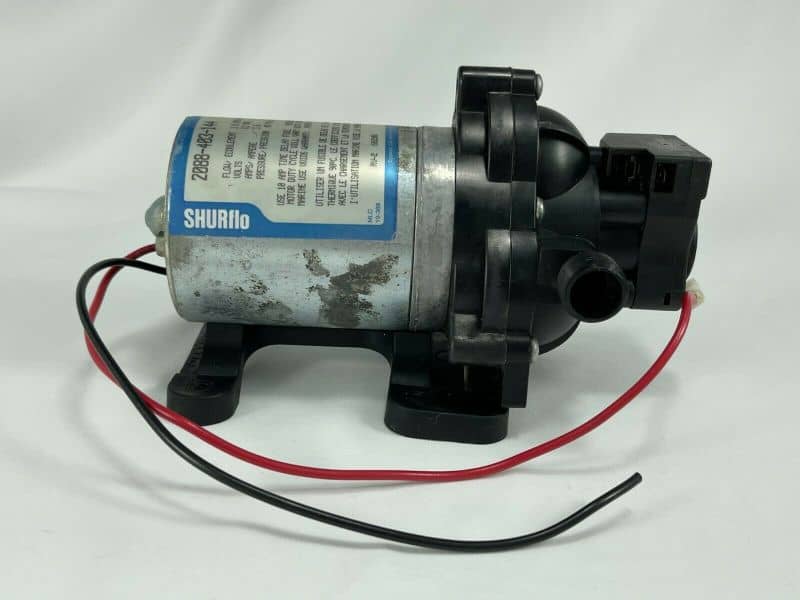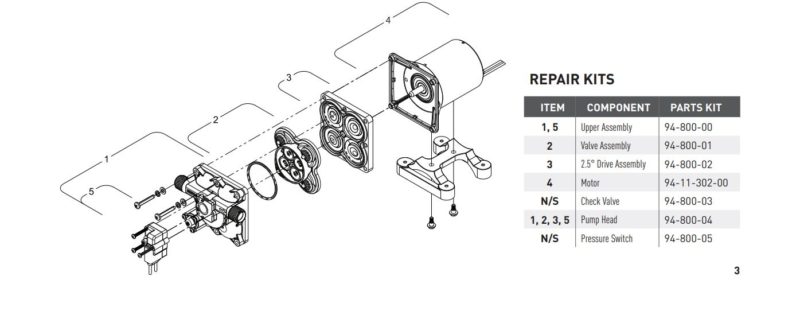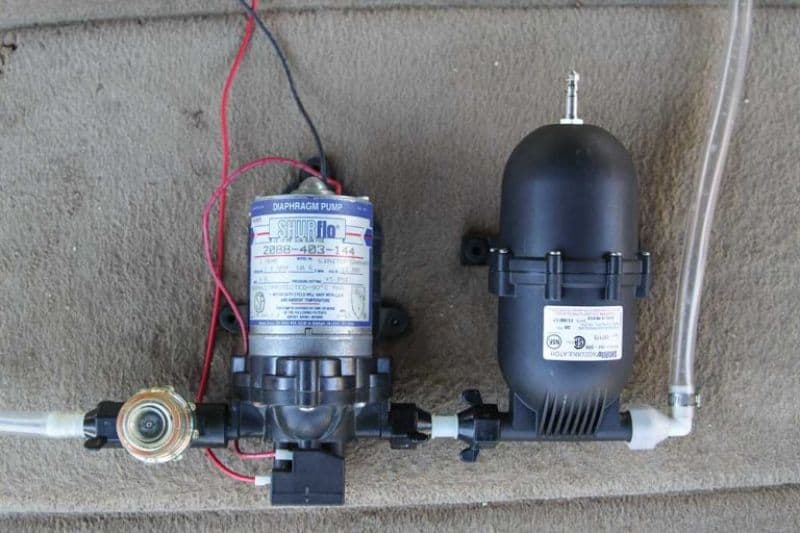Most RVs are equipped with an on-demand water pump.
The water pump is the heart of your freshwater system. It pressurizes the water from your fresh water tank for delivery to your sinks, showerheads, and toilets.
An RV water pump is powered by 12V electricity from your battery. When you open a faucet or flush a toilet, the pump detects a drop in pressure. It will cycle on and pump water through the supply lines until the flow is cut off and the pressure rises.
Some noise from the water pump is normal when you open a tap. But if you’re hearing a hammering or rattling sound (especially when the water isn’t running), something could be seriously wrong!

You must rely on your water pump any time you’re not connected to a city water supply. It’s an essential for dry camping and boondocking!
It’s also one of the few appliances that will run off the batteries alone.
How to Select an RV Water Pump
RV water pumps are rated by their maximum flow rate, usually in gallons per minute (GPM). Typical ranges are:
- 2.7-3.0 GPM for small-to-medium RVs
- 4-5.5 GPM for larger RVs and motorhomes
A note on flow rates – those are not real-world values. Sure, the pump achieved 2.9 gallons per minute in a lab test. But in your RV, with 50 feet of ½” PEX pipe and 8 elbows between the pump and your sink? Not likely!
Water pumps are also rated by their operating pressure.
- Most are designed to operate at 40-55 psi, which is a safe range for most RVs.
- Variable-speed, high-pressure pumps, such as AquaJet, may have an operating pressure of 65 psi. We’ll talk more about this later.
Chances are your RV water pump is made by one of these companies:
- Flojet, by Xylem
- Shurflo, by Pentair
- AquaJet, by Remco Industries
- Aquatec
- SeaFlo, by Xiamen Doofar Outdoor Co
Shurflo and Flojet pretty much control the OEM market, with Aquatec a distant third. AquaJet is the premium aftermarket replacement option; SeaFlo is a cost-effective aftermarket replacement.
How Does an RV Water Pump Work?
A water pump isn’t a particularly complicated piece of equipment. It’s a motor-driven diaphragm pump, usually with 3-5 chambers.
There’s a motor drive assembly, valve assembly, and pump head kit. Inside the pump head is a rubber diaphragm, check valve, and –

– Actually, I’m not going to spill much digital ink telling you how an RV water pump works. That’s because it doesn’t matter.
Four times out of five, if your water pump “goes bad,” you’ll just replace it. Doesn’t matter whether the diaphragm ruptures, the check valve wears out, or the motor bearings seize. Out with the old; in with the new.
That’s because basic on-demand water pumps are relatively cheap, between $50 and $200 retail. If you’re paying a dealership for repair, you’ll pay 2x in labor costs what it would have cost you just to buy a new pump.
However … if you’re a DIY RV-er sort of person, you can purchase pump repair kits to fix a pump yourself for a fraction of the cost. A new valve assembly can make an old water pump work just like new!
If all you need to do is replace a valve assembly, check valve or pressure switch, you can save some money replacing those parts yourself. But if you have a cracked housing or faulty motor, best to bite the bullet and buy a new pump.
RV water pumps usually last 5-10 years (some can last 15-20 years). Once they die, they can usually be replaced in 30-40 minutes. The troublesome thing is usually getting to the pump in the first place!
How Do I Maintain My Water Pump?
Thankfully, water pumps don’t require more than occasional maintenance.
- Winterize properly! Don’t let your water pump freeze or run dry for an extended period of time.
- Sanitize properly! Once a year, sanitize your water system. This will prevent the buildup of lime scale (yuck) or algae (gross), which can damage your pump’s moving parts, especially the valve assembly.
- Use an inline water filter. Use one whether you’re connected to city water or filling your freshwater tank. Also, keep your water hose clean and sanitized!
- Use a pump strainer. These usually connect directly to the pump head. These mesh filters prevent gunk, sediment and plastic shavings from the freshwater tank from getting inside the delicate components of your water pump. You’ll need to clean and possibly replace your pump strainer once a year.
Here’s what Shurflo has to say on the matter:
“Lack of sanitizing is the number one reason for premature pump failure and poor performance over time. Lack of sanitizing will cause scale buildup on the diaphragm and valves, causing low flow and leak back [occasional pump cycling with no faucets open or tank filling up when hooked up to city water].”
I won’t regurgitate the whole manual. You can read it yourself here. And you should! Shurflo tells you exactly how to install, maintain and troubleshoot their ever-popular 4008 water pump.
Why Is My Water Pump So D*MN NOISY?!
Run-of-the-mill on-demand water pumps are somewhat noisy by nature! They run at a constant speed. They’re either off or on.
But if your water pump is giving your generator a run for its money, you might have a problem.
If you’re camping in a brand-new RV, it’s possible the RV manufacturer screwed up. Maybe they didn’t fasten the pump down all the way. Maybe they mounted the pump a dozen feet away from the fresh water tank, causing the pump to work harder (and louder!).
Get a visual on the pump. Have someone else turn the faucets off and on. See if the problem occurs at a trickle or a flood.
If this is a new problem, you might have air in the system (between the pump and the fresh water tank). Air in the system usually shows up as burbs and sputters at the faucets. You’ll need to thoroughly bleed the system.
You also might have a restricted inlet due to a kinked hose or clogged strainer.
If you suspect an electrical problem, I recommend starting with this primer article from The RV Doctor. But more often than not, a noisy pump is a mounting problem.
- The pump should be mounted on rubber grommets or foam pad.
- Screws should be just tight enough to secure the pump, no more!
- Nothing should be touching the pump housing.
- The manufacturer should have used flex lines to connect the inlet and outlet valves to the main PEX water distribution system.*
*If the manufacturer did NOT use flex lines but instead plumed the pump directly to rigid PEX, then that’s a likely source of your problem. The PEX pipe will pulsate when the pump turns on. If it runs through the underside of a cabinet, for instance, that can literally turn your cabinet into a drum!

If that’s the case, you’ll either need to re-plumb your pump with flex lines, or you can dampen vibrations by wrapping your water lines in pipe insulation.
When Should I Turn Off My Water Pump?
There’s a big problem with the typical RV water pump. It’ll kick on anytime it senses a drop in pressure, whether that drop comes from you jumping in the shower, or from a busted water line!
There are quite a few horror stories of RV owners who found their beloved RVs completely flooded because of a frozen pipe, leaky fitting, or in one case, a cat that accidentally opened a faucet.
You also don’t want your water pump turned on when you’re connected to city water. The city water is already pressurized; you don’t need a pump.
So anytime you want water (and you’re not connected to city water AND you have fresh water in your tank), then turn on your water pump. The rest of the time, keep it off.
- Turn off your pump if you’re connected to city water.
- Turn off your pump if your freshwater tank is empty.
- Turn off your pump while you’re driving.
- Turn off your pump while your RV is in storage.
- Turn off your pump if there’s a risk of water freezing in the supply lines.
‘Tis best to err on the safe side and turn off your water pump anytime you’re away from your RV from an extended period, such as an afternoon hiking. Some people even turn off your water pumps at night, just in case a leak springs at 2:00 a.m.!
Why Is My RV Water Pump Randomly Turning On?
If your RV water pump is cycling when you’re NOT running any water, you have a problem. Most likely, you have a water leak. The more your water pump cycles, the worse your leak.
Common leak culprits are:
- Leaky toilet due to bad ball valve
- Slow drips out a faucet or shower head
- Leaks from the low-point drains
- (Horror!) leaks from busted pipe or seeping fittings
- An internal leak from the pump due to a ruptured diaphragm
Here’s how to solve the problem.
- First, check your faucets and toilet.
- Next, start looking for puddles and water stains.
- Finally, you might need to disassemble the pump itself.
You might also have plastic shavings in the valve assembly. This is a somewhat common problem with new RVs when the freshwater tanks or PEX pipes aren’t thoroughly cleaned before installation.
Lastly, check to see if the by-pass pressure is set higher than shut-off pressure. If mechanical things scare you, you might need an RV technician to help with this.
You can learn more about troubleshooting an RV water pump from this article, courtesy of RVDA.
Why Is My Water Pump Hammering?
If your water pump is rapidly cycling (called “hammering”) while turned on, you’ll drastically shorten the lifespan of your pump.
There are a couple of reasons a pump could be hammering.
One possibility is because of excessive restrictions in the water lines or an undersized pump. This can happen with old RVs because of scale and sediment buildup, or it can happen with new RVs because of plastic shavings getting stuck in the PEX.
Another common cause of hammering is low water flow. If you’re trickling water out of faucet, the pump either won’t turn on at all, or it’ll “hammer.” Adding an accumulator tank (see below) can often fix this problem.
There are two basic ways to fix a hammering pump:
- Add an accumulator tank. These are also known as expansion tanks or pulsation dampers. To be honest, these are becoming more and more rare. Most bypass pumps and variable-speed pumps aren’t supposed to be used with accumulator tanks.
- Adjust the pressure setting. Most mainstream RV water pumps allow you to adjust the pressure settings by turning a screw on the pump housing. The pump should be adjusted so the pump shuts off for at least 2 seconds or more between cycles.

Here are directions from Shurflo how to adjust the shut-off pressure and bypass pressure on the 4008 Revolution pump:
“The by-pass is a spring loaded diaphragm that opens up allowing water from the discharge side back to the inlet side. The by-pass is set to begin opening at about 40 psi and creating full by-pass at about 62 psi (lower pressure pumps will vary depending on the by-pass and pressure shut-off settings). The pressure switch on the pump is set to shut off at 55 psi. If the switch or by-pass are adjusted too much, the by-pass and switch shut-off can overlap and THE PUMP WILL NOT SHUT OFF.
“Screwing the switch screw in clockwise will raise the shut-off pressure. Unscrewing the switch screw counterclockwise will lower the pump shut-off pressure. Screwing the by-pass screw in will raise the pressure at which the by-pass starts and raise the full by-pass pressure. Unscrewing the by-pass screw counterclockwise will lower the pressure at which by-pass starts and lower the full by-pass pressure.
“WARNING: If full by-pass is reached before the shut-off setting, the pump will not shut off. Full by-pass pressure setting should be at least 10 psi higher than pump shut off pressure.”
Can I Replace My Water Pump With a Bigger Version?
Hmm, maybe. There’s nothing inherently stopping you from upgrading to higher-quality pump, especially a variable-speed version.
But watch out for system pressure!
Most RV water systems are tested to 80-100 psi and are expected to operate in service at 35-55 psi. Meanwhile, a normal RV pump (like the ubiquitous Shurflo 4008) has an operating pressure of around 45 psi.
But a few premium variable-speed pumps, such as Remco Aqua Jet, operate at 65 psi, have a shut-off pressure range of 75-85 psi!
That’s asking for an explosive leak in many RVs! You need to confirm with your RV manufacturer that your water lines can handle this higher pressure, especially at higher temperatures.
Parting Thoughts
I could write a lot more about RV water pumps. And in fact, a lot of people have! It’s a pretty common forum topic (almost as common as “how to winterize.”)
But the truth is that living with an RV pump is usually pretty easy. Don’t run it dry, turn it off when you’re not using water from your tank, and sanitize every year. And then, hopefully, you can forget about it!
Leave a Reply